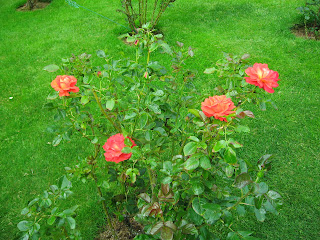 |
| March 4, 2009 |
 |
| March 26, 2010 |
 |
| April 4, 2009 |
 |
| March 15, 2010 |
 |
| March 1, 2009 |
 |
| March 23, 2009 |
 |
| March 20, 2009 |
 |
| March 31, 2009 |
 |
| April 7, 2010 |
OK, so I snuck one in that slightly exceeds the 8 petal limit, but I'm not naming names. Seriously, though, keep the above images in mind when you read my post of December 6, 2011 titled "The BIG rose". There I theorize about the ancestry of the 'Queen Elizabeth' rose. Since 23 percent of my self-pollinated 'Queen Elizabeth' seedlings (9 out of 39) are "singles", I believe that this points very strongly to Rosa roxburghii normalis (not Rosa roxburghii plena) as being one of the grand-parents of the 'Queen Elizabeth' rose.
Update of October 13, 2012: But then again, sometimes I'm not sure what to think. Literature I've recently read indicates that both the "normalis" and the "plena" versions of Rosa roxburghii have spiny calyxes on their rose buds. Not a single one of my 39 self-pollinated 'Queen Elizabeth' seedlings exhibits this characteristic. Referring to my post of December 6, 2011 again: Maybe the grand parent in question was indeed Rosa multibracteata . . . OR . . . maybe 'Baby Chateau' did indeed self pollinate to produce 'Floradora' !
Update of October 18, 2012: Let's take a closer look at the seedling born on March 1, 2009 -- see the fifth photo above. Of all my 'Queen Elizabeth' seedlings, this rose looks the most like some wild species rose from the Orient. How about Rosa bracteata? ( R. multibracteata is more pinkish); see Google Images for some photos of R. bracteata. Below are two photos that I took today of the seedling rose bush. The flower really has an extremely high-pointed bud, which unfurls very easily. What's really confounding is that this rose bush is only 14 inches tall toward the end of its 4th growing season. The plant is complemented beautifully by the carpet of moss.
Update of October 13, 2012: But then again, sometimes I'm not sure what to think. Literature I've recently read indicates that both the "normalis" and the "plena" versions of Rosa roxburghii have spiny calyxes on their rose buds. Not a single one of my 39 self-pollinated 'Queen Elizabeth' seedlings exhibits this characteristic. Referring to my post of December 6, 2011 again: Maybe the grand parent in question was indeed Rosa multibracteata . . . OR . . . maybe 'Baby Chateau' did indeed self pollinate to produce 'Floradora' !
Update of October 18, 2012: Let's take a closer look at the seedling born on March 1, 2009 -- see the fifth photo above. Of all my 'Queen Elizabeth' seedlings, this rose looks the most like some wild species rose from the Orient. How about Rosa bracteata? ( R. multibracteata is more pinkish); see Google Images for some photos of R. bracteata. Below are two photos that I took today of the seedling rose bush. The flower really has an extremely high-pointed bud, which unfurls very easily. What's really confounding is that this rose bush is only 14 inches tall toward the end of its 4th growing season. The plant is complemented beautifully by the carpet of moss.
 |
| Morning of October 18, 2012 |
 |
| Afternoon of October 18, 2012 |









